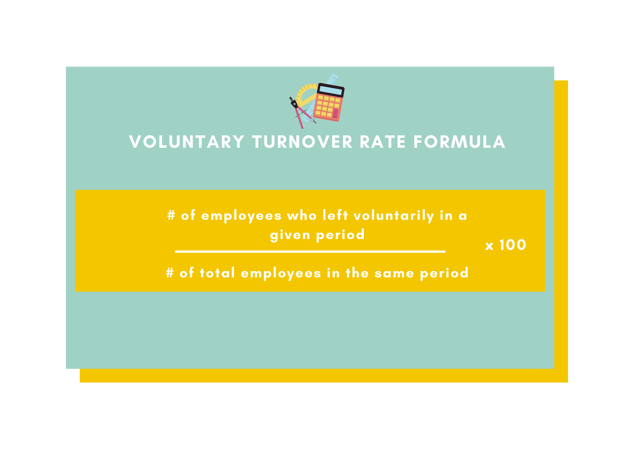Voluntary Turnover Rate
Voluntary turnover rate is an HR metric that reflects the rate at which employees at an organization voluntarily elect to leave the company. Involuntary turnover, on the other hand, results from employees departing due to reasons that are not personally driven.
Voluntary turnover occurs for a number of reasons, including dissatisfaction with their position or compensation, desires for a career change, or something else entirely.
Especially in the current context, voluntary turnover is becoming more and more common. In fact, the number of US workers voluntarily leaving their jobs in 2021 was at a record high. There are a number of reasons for this, including pandemic fears, child care difficulties, and a massive demand for new talent that has created a favorable market (and unprecedented levels of choice) for job seekers.
Because of things like recruiting and hiring costs, as well as the cost of having a vacant position, job turnover is expensive for companies. It’s therefore important for organizations to have a clear understanding of what the term means, specifically as it relates to the performance of their business.
How to calculate voluntary turnover rate?
HR professionals can learn a lot through the analysis of voluntary turnover rates. Primarily, it indicates room for improvement from an employer’s perspective (e.g. assessing how to create more flexibility, work-life balance, and productivity for employees).
To calculate voluntary turnover rate first determine the number of employees who left the organization voluntarily in a given time period. Then, determine the number of employees employed during that same time period. Next, divide the number of voluntary departures by the employee count. Finally, multiply this figure by 100 to calculate your voluntary turnover rate.
Here is the formula:

How to limit voluntary turnover?
First, let's think about the main reasons behind voluntary turnover. These include:
- Career progression/change in passions
- Poor management
- Job dissatisfaction
- Toxic workplace culture
- Lack of flexibility
- Lack of growth opportunities
- Poor compensation
- Worker fatigue
- Child care considerations
While there are certain things out of your control as an employer, there are things that you can do to limit voluntary turnover. Here are a few:
- Start with a solid hiring process: during the interview process, it's important to make sure a prospective employee is a good fit for a particular position. Considerations of satisfaction and fulfillment, adequate compensation, etc. all factor in here. Some companies administer personality tests to see if certain personality traits indicate compatibility with the demands of a certain position.
- Provide a more flexible workplace: things like flexible working hours and remote work can go a long way.
- Check-in: make sure to regularly check in with employees. With access to management and support, it's vital that workers feel they are heard and cared for at their place of employment.
- Pay more (where possible): be creative in how you compensate employees (e.g. work anniversary bonuses).
- Provide learning opportunities: support career goals and paths, and making sure that there is room for both, can be very helpful. Think peer learning, promotion paths, etc.
- Ask! Stay and exit interviews are two effective ways to learn why employees stay (or don’t stay) at your organization. Take action to address the problems you uncover.
- Focus on culture: inclusive work environments foster productivity, respect, enjoyment and, yes, retention!
Is voluntary turnover a bad thing?
Voluntary turnover isn’t always a bad thing. Why? Because it can create opportunities for fresh talent, new ideas, and considerations of what’s most important for a business at a given time. That being said, high voluntary turnover rates are usually expensive, unexpected, and disrupting.
There are generally two types of voluntary turnover that employers can consider: functional voluntary turnover and dysfunctional voluntary turnover.
Functional turnover indicates poor performers that leave an organization. If, for example, an employee that is always late or that frequently fails to meet their performance goals leaves the organization, it is an example of functional turnover.
Dysfunctional turnover, on the other hand, is what employers should most seek to avoid. It is when top performers leave an organization. An example of this would be when a good employee leaves for another company because they got a better compensation package.
A good people analytics strategy should help identify both underperformers as well as high performers.
The last word
Understanding voluntary turnover rates help to develop and execute strategies that help retain top talent and build a more engaged, high-performing team. There is always something you can do!
This, amongst other HR KPIs, is vital to success today. And what’s more is that you can always start small, like creating an easy and effective HR dashboard.


